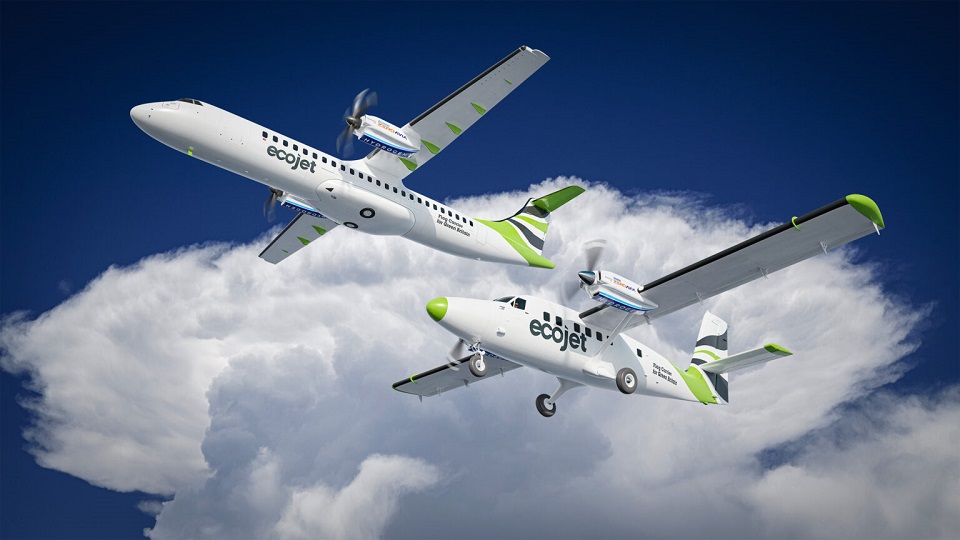Aerospace
New UK Airline Ecojet Signs Deal For 70 ZeroAvia Engines

ZeroAvia announced that it has reached a deal with Ecojet, a recently established airline, for up to 70 engines that run entirely on hydrogen and emit no emissions.
In 2024, Ecojet, which wants to be the premier airline for green Britain, will start flying to and from Edinburgh using conventional aircraft. Later, it will convert its fleet to become the first ever electric airline in history.
Once certified, the airline will retrofit its aircraft with ZeroAvia’s ZA600 engines to accomplish its goal. MONTE, ZeroAvia’s preferred ZA600 lessor partner, will collaborate with Ecojet to commercialize this innovative technology. By 2025, ZeroAvia hopes to have the ZA600 engine type certified.
The recently established airline has also placed a larger order for the more potent ZA2000 engine, which is intended for regional turboprops with up to 80 seats and a 2027 entry-in-service target. This will make it possible to fly planes like the Dash 8 400 and ATR72, which are already widely used on international regional routes.
In collaboration with airports and other industry partners, ZeroAvia, Ecojet, and MONTE will determine and fund the initial routes for hydrogen-electric commercial operations. According to ZeroAvia analysis, domestic flights would have lower lifecycle carbon emissions per passenger than any other popular mode of transport available today, including fully occupied cars, domestic rail and coach travel, if they were powered by green hydrogen produced by wind energy in the UK.

Aerospace
Boeing Transfers Rocket Stage to NASA, Paving Way for Human Moon Mission

Boeing has achieved a significant milestone by providing NASA with the second core stage of the Space Launch System (SLS) rocket.
This crucial component, crafted at NASA’s Michoud Assembly Facility (MAF), is set to propel the Artemis II crew into lunar orbit, marking humanity’s return to deep space after a 50-year hiatus.
The monumental Boeing-built rocket stage, the largest element of the Artemis II mission, will embark on a journey aboard the Pegasus barge, traveling 900 miles to NASA’s Kennedy Space Center.
Comparison of two legendary aircraft B777x vs B747 aircraft:Click here
Upon arrival, it will be meticulously integrated with other essential Artemis II components, including the upper stage, solid rocket boosters, and NASA’s Orion spacecraft within the iconic Vehicle Assembly Building. This intricate integration process is a vital step toward the eagerly anticipated Artemis II launch, slated for 2025.
“Boeing-built products helped land humankind on the moon in 1969, and we’re proud to continue that legacy through the Artemis generation,” remarked Dave Dutcher, vice president and program manager for Boeing’s SLS program. “Together, with NASA and our industry partners and suppliers, we are building the world’s most capable rocket and paving the way to deep space through America’s rocket factory in New Orleans.”
NASA, Lockheed Martin Reveal X-59 Quiet Supersonic Aircraft:Click here
The delivery of Core Stage 2 marks a significant achievement in the evolution of the SLS rocket. Towering over 200 feet and powered by four RS-25 engines, this core stage, coupled with two solid-fueled booster rockets, will generate a staggering 8.8 million pounds of thrust. This immense power is crucial to launching Artemis II and future missions into the vast expanse of space.
The SLS rocket stands unparalleled in its capability to transport both crew and substantial cargo to the moon and beyond in a single launch. Its extraordinary capacity will facilitate the delivery of human-rated spacecraft, habitats, and scientific missions to destinations including the moon and Mars, ushering in a new era of space exploration.
-

 Travel1 week ago
Travel1 week agoAir India to Expand US Operations with Three New Routes After a Decade
-

 Travel2 weeks ago
Travel2 weeks agoWhy We Should Avoid These Stamps in a Passport
-

 Airlines1 month ago
Airlines1 month agoInvestigations Reveal Fake Chinese Titanium in Boeing and Airbus Jets
-

 Tech4 weeks ago
Tech4 weeks agoChina’s CATL Plans 1,800-Mile Electric Plane Launch by 2027
-

 Airport3 days ago
Airport3 days agoTop 10 Largest Airports in the World by Size
-

 Aerospace4 weeks ago
Aerospace4 weeks agoChina’s Fighter Jets Turn Wings into Autonomous Drones
-

 Airlines4 days ago
Airlines4 days agoAir India Rolls Out A350s for Delhi-New York JFK and Newark Routes
-

 Defence3 weeks ago
Defence3 weeks agoBoeing Enhances Chinook with New Engines and Block II Upgrades at $96 Million







